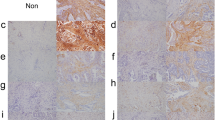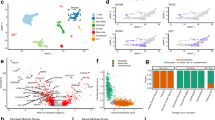Abstract
The acquisition of a metastatic phenotype by epithelial cells implicates a series of changes altering their differentiation, their overall behavior and morphology. In the present study, we have examined the relationships between the cellular morphology, E-cadherin expression, matrix metalloproteinases expression and in vitro invasive properties in two human bronchial immortalized cell lines. The (16HBE14o-) cell line which did not show any invasive abilities in the Boyden chamber assay displayed a typical epithelial morphology in monolayer, expressed high levels of E-cadherin and synthesized neither MMP-2 and MT1-MMP nor vimentin. In contrast, the BZR cell line which was highly invasive displayed a more elongated phenotype in monolayer, did not produce E-cadherin but expressed vimentin, MMP-2 and MT1-MMP. Our data therefore suggest that the metastatic progression of broncho-pulmonary cancer cells results in a cellular dedifferentiation and the gain of some mesenchymal attributes (loss of E-cadherin and expression of vimentin) associated with enhanced degradative properties (expression of metalloproteinases).© Rapid Science 1998
Similar content being viewed by others
References
Takeichi M, 1988, The cadherins: cell-cell adhesion molecules controlling animal morphogenesis. Development, 102, 639-55.
Shiozaki H, Oka H, Inoue M, Tamura S and Monden M, 1996, E-cadherin mediated adhesion system in cancer cells. Cancer (suppl.), 77, 1605-13.
Shipper JH, Frixen UH, Behrens J, Unger A, Jahnke K and Birchmeier W, 1991, E-cadherin expression in squamous cell carcinomas of head and neck: inverse correlation with tumor dedifferentiation and lymph node metastasis. Cancer Res, 51, 6328-37.
Oka H, Shiozaki H, Kobayashi K et al.1993, Expression of E-cadherin cell adhesion molecules in human breast cancer tissues and its relationship to metastasis. Cancer Res, 53, 1696-1701.
Frixen UH, Behrens J, Sachs M et al.1991, E-cadherin-mediated cell-cell adhesion prevents invasiveness of human carcinoma cells. J Cell Biol, 113, 173-85.
Sommers CL, Thompson EW, Torri JA et al. 1991, Cell adhesion molecule uvomorulin expression in human breast cancer cell lines: relationship to morphology and invasive capacities. Cell Growth Different, 2, 365-71.
Vlemincks K, Vakaet, LJ, Mareel M, Fiers W and Van Roy RF, 1991, Genetic manipulation of E-cadherin expression by epithelial tumor cells reveals an invasion suppressor role. Cell, 66, 107-19.
Behrens J, Mareel MM, Van Roy FM and Birchmeier W, 1989, Dissecting tumor cell invasion: epithelial cells acquire invasive properties after the loss of uvomorulin. J Cell Biol, 108, 2435-47.
Polette M and Birembaut P, 1996, Metalloproteinases and breast carcinomas. Breast J, 2, 1-13.
Stetler-Stevenson WG, 1990. Type IV collagenases in tumor invasion and metastasis. Cancer Metastasis Rev, 9, 289-303.
Brown PD, Bloxridge RE, Anderson E and Howell A, 1993, Expression of activated gelatinase in human invasive breast carcinoma. Clin Exp Metastasis, 11, 183-9.
Davies B, Miles DW, Happerfield LC, et al. 1993, Activity of type IV collagenases in benign and malignant breast disease. Br J Cancer, 67, 1126-31.
Azzam H, Arrand GA, Lippman ME and Thompson EW, 1993, MMP-2 activation potential associates with metastatic progression in human breast cancer cell lines, and is independent of MMP-2 production. J Natl Cancer Inst, 85, 1758-64.
Gilles C, Polette M, Piette J, Birembaut P and Foidart JM, 1994, Epithelial to mesenchymal transition in HPV-33-transfected cervical keratinocytes is associated with increased invasiveness and expression of gelatinase A. Int J Cancer, 59, 661-6.
Yu M, Sato H, Seiki M and Thompson EW, 1995, Complex regulation of membrane-type matrix metalloproteinase expression and matrix metalloproteinase-2 activation by concanavalin in MDA-MB-231 human breast cancer cells. Cancer Res, 55, 3272-7.
Sato H, Takino T, Okada Y et al.1994, A matrix metalloproteinase expressed on the surface of invasive tumor cells. Nature, 370, 61-5.
Gilles C, Polette M, Piette J et al.1996, High level of MT-MMP expression is associated with invasiveness of cervical cancer cells. Int J Cancer, 65, 209-13.
Yamamoto M, Mahanam S, Sawaya R et al.1996, Differential expression of membrane-type matrix metalloproteinase and its correlation with gelatinase A activation in human malignant brain tumors in vivoand in vitro. Cancer Res, 56, 384-92.
Okada A, Bellocq JP, Rouyer N et al.1995, Membrane-type matrix metalloproteinase (MT-MMP) gene is expressed in stromal cells of human colon, breast, and head and neck carcinomas. Proc Natl Acad Sci USA, 92, 2730-4.
Nomura H, Sato H, Seiki M, Mai M and Okada Y, 1995, Expression of membrane type matrix metalloproteinase in human gastric carcinomas. Cancer Res, 55, 3263-6.
Polette M, Nawrocki B, Gilles C et al.1996, MT-MMP expression and localisation in human breast and lung cancers. Virchows Arch, 428, 29-35.
Cozens AL, Yezzi MJ, Kunzelmann K et al.1994, CFTR expression and chloride secretion in polarized immortalized human bronchial epithelial cells. Am J Respir Cell Mol Biol, 10, 38-47.
Ura H, Bonfil RD, Reich R et al.1989, Expression of type IV collagenase and procollagen genes and its correlation with the tumorigenic, invasive, and metastatic abilities of oncogene-transformed human bronchial epithelial cells. Cancer Res, 49, 4615-21.
Kleinman HK, McGarvey ML, Hasel JR et al.1986, Bm complexes with biological activity. Biochemistry, 5, 312-18.
Gamello C, Palacios J, Suaerz A et al.1993, Correlation of E-cadherin expression with differentiation grade and histological type in breast carcinoma. Am J Pathol, 142, 987-93.
Böhm M, Tozeck B, Birchmeier W and Wiesland I, 1994, Differences of E-cadherin expression levels and patterns in primary and metastatic human lung cancer. Clin Exp Metastasis, 12, 55-62.
Thompson EW, Paik S, Brünner N et al.1992, Association of increased basement membrane invasiveness with absence of estrogen receptor and expression of vimentin in human breast cancer cell lines. J Cell Physiol, 150, 534-44.
Bae NS, Arand G, Azzam H, et al.1993, Molecular and cellular analysis of basement membrane invasion by human breast cancer cells in Matrigel-based in vitroassays. Breast Cancer Res Treat, 24, 214-55.
Sommers CL, Byers SW, Thompson EW, Torri JA and Gelmann EP, 1994, Differentiation state and invasiveness of human breast cancer cell lines. Breast Cancer Res Treat, 31, 325-35.
Gilles C and Thompson EW, 1996, The epithelial to mesenchymal transition and metastatic progression in carcinoma. Breast J, 2, 83-96.
Guarino M, 1995, Epithelial-to-mesenchymal change of differentiation. From embryogenetic mechanism to pathological patterns. Hist Histopathol, 10, 171-84.
Thiery JP, Duband JL and Tucker GC, 1985, Cell migration in the vertebrate embryo: role of cell adhesion and tissue environment in pattern formation. Ann Rev Cell Biol, 110, 91-113.
Buisson AC, Gilles C, Polette M, Zahm JM, Birembaut P and Tournier JM, 1996, Wound repairinduced expression of stromelysins is associated with the acquisition of a mesenchymal phenotype in human respiratory epithelial cells. Lab Invest, 74, 658-69.
Nawrocki B, Polette M, Marchand V et al.1997, Expression of matrix metalloproteinases and their inhibitors in human broncho-pulmonary carcinomas: quantitative and morphological analyses. Int J Cancer(in press).
Crawford HC and Matrisian LM, 1994, Tumor and stromal expression of matrix metalloproteinases and their role in tumor progression. Inv Metastasis, 14, 234-45.
Author information
Authors and Affiliations
Rights and permissions
About this article
Cite this article
Polette, M., Gilles, C., de Bentzmann, S. et al. Association of fibroblastoid features with the invasivephenotype in human bronchial cancer cell lines. Clin Exp Metastasis 16, 105–112 (1998). https://doi.org/10.1023/A:1006572204497
Issue Date:
DOI: https://doi.org/10.1023/A:1006572204497




